Blog
Innovators Profiles
The Frugal Bottle - a conversation with Malcolm Waugh
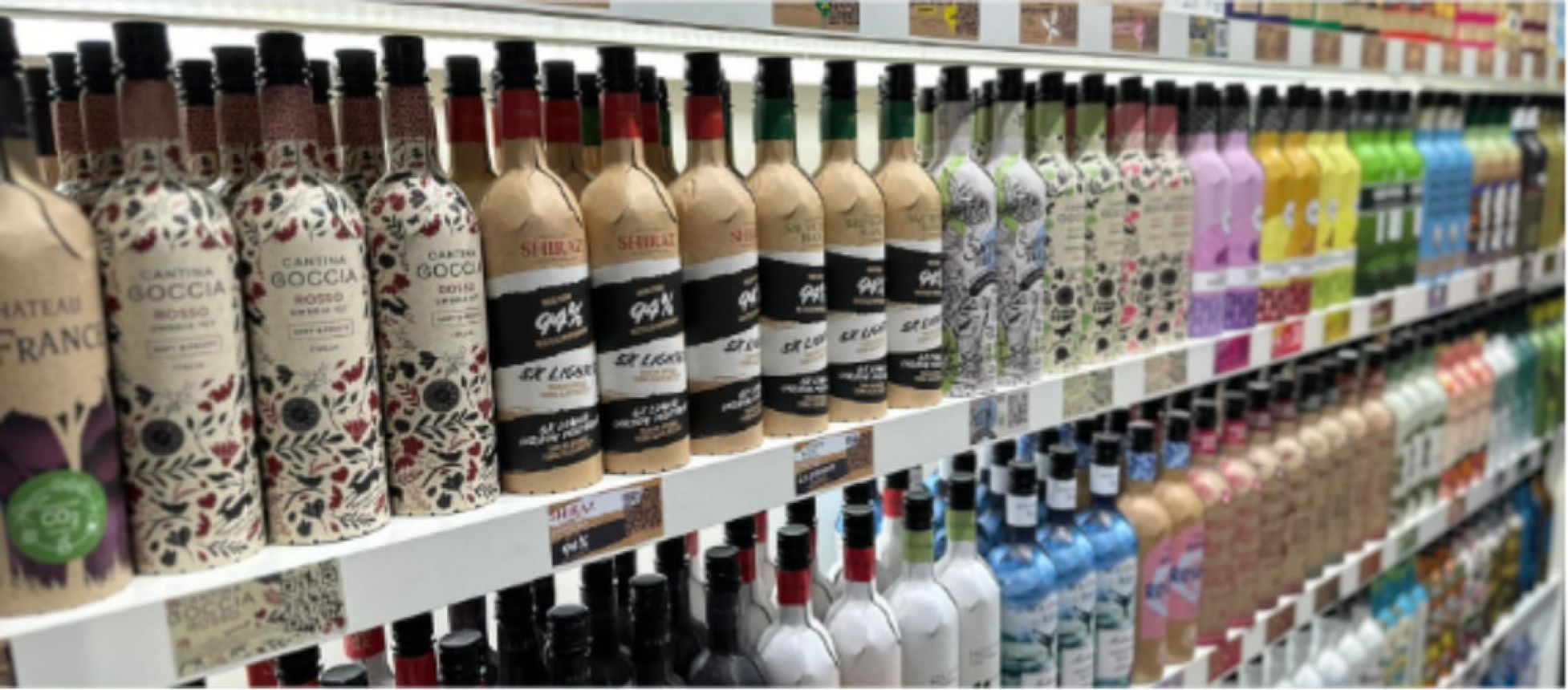
Frugalpac’s CEO shares an in-depth account on their new-age sustainable bottles, and invites wine makers and spirit distillers to contribute in saving the planet.
As sustainability becomes an increasingly urgent priority in the beverage sector, innovative packaging solutions are critical to meeting both environmental goals and evolving consumer expectations. Enter the Frugal Bottle by Frugalpac — a revolutionary, lightweight, recyclable paper-based bottle designed specifically to disrupt the traditional glass packaging model. Offering up to six times less carbon footprint than conventional bottles, the Frugal Bottle not only champions eco-friendly production but also unlocks new creative possibilities with its unique 360-degree printable surface. This innovation is already gaining traction worldwide among wineries, distilleries, distributors, and retailers. In the following Q&A with Frugalpac CEO Malcolm Waugh, we explore how Frugalpac’s pioneering technology empowers brands to scale sustainability without sacrificing design or cost-efficiency, and what the future holds for this groundbreaking packaging solution in the global alcoholic beverage market.
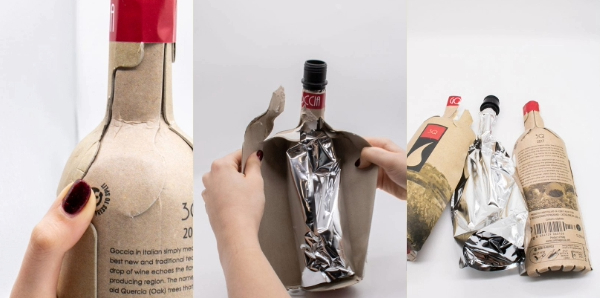
Source: Frugalpac
1. Let’s begin with the Frugalpac story—what was the original inspiration behind creating a packaging company with such a strong sustainability ethos?
We’re a young British innovation company that looks at the environmental problems caused by traditional packaging in fast-moving consumer goods. Our first major product was a recyclable, low-carbon paper coffee cup, which launched in 2019. However, when the pandemic hit and coffee shops shut down, we had to change strategies.
We already had the concept of the Frugal Bottle in mind, and the idea took shape from there. The wine industry, in particular, is heavily impacted by climate change, and about 50% of its carbon footprint comes from packaging—especially glass bottles. The carbon cost of glass comes not only from raw material extraction but also from the high-energy process required to melt glass. Then there’s the issue of transporting these bottles, often manufactured in India, China, or Eastern Europe. We saw a need for a sustainable alternative. And since the wine industry is very traditional, we set out to create something that looks, feels, and functions like a glass bottle—but is made of paper. That became the Frugal Bottle, which is now our flagship product. The Frugal Bottle has up to six times less carbon impact than a traditional glass bottle, which is a major differentiator for environmentally conscious consumers.
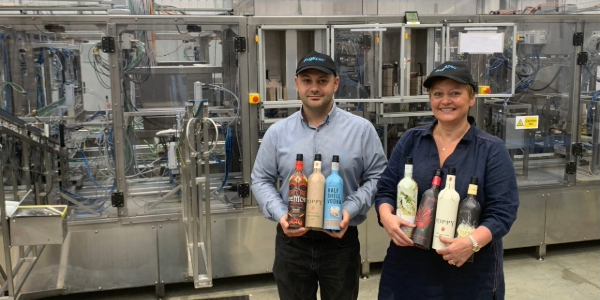
Source: Frugalpac
2. Frugalpac is known for its low-carbon footprint products made from recycled paper. Can you walk us through the creation of a Frugal Bottle, from recycled material to shelf-ready product?
Certainly. The Frugal Bottle begins as recycled paper, specifically 94% recycled content known as greyboard. We add a 6% virgin paper facing on the front for two reasons: it improves liquid resistance and provides a clean surface for high-quality printing. That layer helps the bottle perform better in humid environments or during filling.
The paper components—front, back, and base disc—are sent out for printing. Once the printed, die-cut board returns, it’s loaded into the machine along with a mono-material pouch made of polyethylene, which holds the liquid. That pouch makes up 16% of the bottle’s weight, while 84% is paper. Although the pouch isn’t yet made from recycled content, we’re working with suppliers to change that.
Inside the machine, we essentially shape paper. We start by forming a tube from the two flat sides, then shape the neck, and finally insert the base, which adds the strength and rigidity needed for the bottle to perform well through the supply chain. After forming, we pressure-test each bottle to check for leaks in the pouch. If a bottle fails, it’s ejected. If it passes, it moves on to palletising and is sent to the customer.
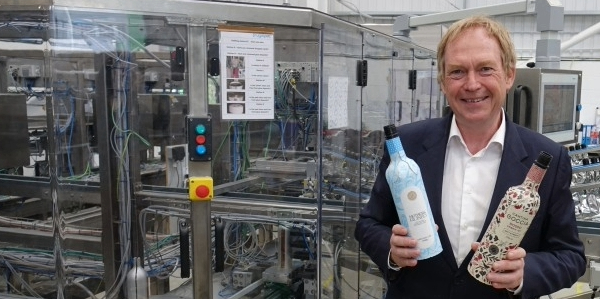
Source: Packaging News
3. How do your paper-based bottles stand up to durability and shelf-life standards, especially for wines that age or travel far?
We’ve done extensive testing before launching the Frugal Bottle. One of the most critical aspects for wine packaging is oxygen transfer—if oxygen gets in, the wine deteriorates. So we developed a mono-material pouch made of advanced polyethylene with barrier properties that prevent oxygen ingress. This pouch gives our bottles a shelf life of at least 12 months. In real-world use, red wines last up to 18 months and whites around 14 months. That’s more than enough for the majority of wines on the market—90% of all wine is consumed within 12 months of bottling, and most of that within 48 hours of purchase.
As for physical durability, the Frugal Bottle is designed to go in and out of refrigerators and even freezers—perfect for both wines and spirits. Structurally, it’s strong enough for the supply chain. It can be stacked four layers high on a pallet, withstands top-load pressure during filling and capping, and works on most existing bottling lines with minimal modification. We also drop-test to 1.6 metres, whereas glass bottles typically break at just 30 centimetres. If a pouch ever does rupture, the liquid is absorbed into the paper instead of causing a messy spill, making clean-up easier.
We’ve shipped empty bottles globally—to the U.S., Europe, South Africa, Australia—and our clients are shipping filled Frugal Bottles worldwide as well, including from Spain and Italy to Japan and Scandinavia. It’s proven to be both durable and fit for long-distance travel.
4. Since you’re a packaging company working with a variety of clients, what kind of customisation or tailored services do you offer—especially considering no two bottles are quite the same?
One of the biggest advantages of the Frugal Bottle is that it starts life flat, giving our customers a full 360-degree printable canvas—even the base. Unlike traditional glass bottles, which are limited to a single label or a plastic sleeve (which can be harder to recycle), our design allows for complete creative freedom at no added environmental cost. We encourage clients to create their own designs, which they send us in concept form. Either we or our print partners turn that into a print-ready layout, which is then sent back for client approval before production.
We also offer a sample service—meaning we can produce one or two fully printed Frugal Bottles for clients to show potential buyers or test in-market. These are working samples, so they can even be filled with wine. There’s no need to commit to large orders like 100,000 bottles; we’re flexible with quantities.
Lastly, we help our clients tell their sustainability story. We share a complete lifecycle analysis of the Frugal Bottle with our partners so they can combine it with their own production metrics and present a verified carbon footprint to the market.
5. You recently received the King’s Award for Enterprise in Innovation—how does this recognition impact your credibility and influence in the beverage sector?
It’s been a tremendous support for everything we do and has really endorsed our work. The award shows that Frugal Bottle isn’t some fleeting innovation—it carries long-term value and relevance. It also gives us a strong credibility boost. This isn’t an award handed out lightly; it reflects the standards we maintain as a business, in both our products and operations. There’s a level of quality implicitly attached to it, which sends a clear message to the industry. We take great pride in that recognition—it’s a powerful validation of our innovation and our mission.
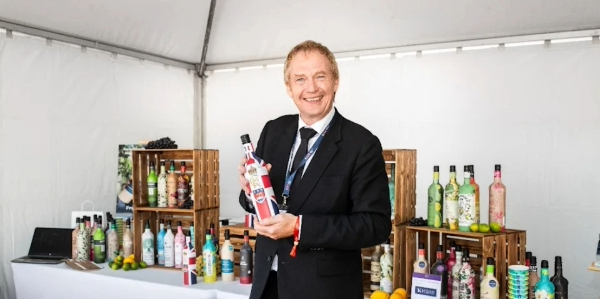
Source: Yahoo! Finance
6. Target in the U.S. recently adopted paper-bottled wines—can you tell us more about how that came to be, and what kind of traction you’re seeing in international markets?
To explain that, it’s helpful to touch on our business model first. Frugalpac is an engineering-led company—we design and build the machines that produce our bottles. Once a machine is tested and running smoothly here, we aim to sell it to regional partners like local wineries or distilleries so they can manufacture bottles locally.
One of our customer’s, Monterey Wine, essentially a contract packer, now has a Frugal Bottle assembly machine and works with a client called LWX, a wine distributor and brand builder. LWX approached Target—one of their retail partners—with the Frugal Bottle as a sustainable packaging solution. Target agreed to bring it in, becoming one of the first major U.S. retailers to adopt it.
We’ve supported that journey all the way—ensuring the machine was properly installed, training the team at Monterey Wine, and offering technical support. An added benefit, especially given current global tariff concerns, is that because the bottles are now made in the U.S. using local materials, they’re exempt from import tariffs. That’s been an unplanned, but valuable, advantage.
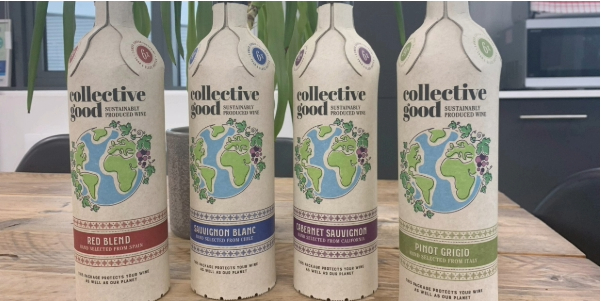
Source: Frugalpac
7. Which global regions or industries are showing the most interest or growth potential for Frugalpac right now?
Our focus is mainly on wine and spirits, and North America—particularly the U.S.—is currently our biggest growth market. Target’s adoption of the Frugal Bottle has certainly helped drive visibility there.
The UK is another key market, with our bottles now in major retailers. We’re also starting to see movement in traditionally slower-adopting wine regions like France, Italy, and Spain, which are beginning to embrace the format. Australia and New Zealand are growing markets as well. And we’ve recently signed a joint venture with ITC in India, where spirits are a major category and wine is emerging fast. Interestingly, countries like India have the potential to leapfrog some of the less sustainable phases that markets like the UK went through during industrialisation. They're starting with sustainability front and center.
8. Tell us about the Frugal Bottle Machine—how does it empower brands or bottlers, and what’s the value proposition behind installing one?
The value proposition starts with the product itself: the Frugal Bottle is a highly sustainable packaging option. It has six times less carbon footprint than an average glass wine bottle, which typically weighs about 440 grams. It’s also five times lighter, making it easier for consumers to handle, especially in markets like North America where case sizes tend to be larger.
The bottle offers a full 360-degree canvas for branding, including the base, which really allows brands to stand out on shelves. Instead of the usual green glass and standard labels, brands can create vibrant, eye-catching designs that differentiate their products.
From a sustainability standpoint, the bottle is already made from 84% recycled material and is fully recyclable again. Now, why install the Frugal Bottle Machine? One major benefit is in logistics and carbon reduction. Whether glass or paper bottles, about 1,000 bottles fit on a pallet. But if you have the machine on-site and buy materials instead of pre-assembled bottles, you can fit about 5,000 assembled bottles on a pallet. That means roughly four fewer trucks on the road, reducing carbon emissions and distribution costs significantly.
Another key advantage is local sourcing. We test materials rigorously and then help customers find local suppliers—so instead of importing glass bottles, wineries or distilleries can produce bottles locally from paper sourced nearby. This not only cuts costs but revitalizes regional supply chains and supports local economies by creating jobs in paper mills, printing, and packaging.
Finally, producing bottles locally with the Frugal Bottle Machine reduces shipping and environmental costs associated with importing finished bottles. This local production model delivers the most sustainable, cost-effective solution possible.

Source: Drinks Business
9. How are you helping customers scale their sustainability commitments without compromising on design or cost-efficiency?
We support customers in scaling their sustainability primarily through the product itself. The Frugal Bottle delivers a massive carbon reduction—around six times less than a traditional glass bottle, which translates to over 420 grams of carbon saved per bottle compared to a 440-gram glass bottle. This represents a significant environmental impact when scaled. From an innovation standpoint, we’re continually developing higher-speed machines and exploring options for different bottle shapes and more flexibility. This ongoing innovation will help customers scale production efficiently without sacrificing design freedom or cost-effectiveness.
Overall, the combination of dramatically lower carbon footprint, local rapid production, and design versatility ensures our customers can grow their sustainability efforts while maintaining strong brand differentiation and cost control.
10. What’s the bigger picture for Frugalpac? Five years from now, what do you hope your impact will be on the packaging industry—and on the planet?
The total addressable market for glass bottles in the typical 70 cl or 750 ml size is enormous—around 33 billion bottles annually worldwide. While it’s a massive opportunity, our current strategic ambition is modest but meaningful: capturing about 0.5% of that market.
That 0.5% market share equates to roughly 220 million bottles produced by 24 machines globally, which would save approximately 88,000 tonnes of carbon emissions each year. Over five years, that adds up to an estimated 300,000 tonnes of carbon saved—equivalent to taking 64,000 cars off the road or powering 2,300 American homes for a year. Even this small foothold in the market could have a significant environmental impact.
Beyond the Frugal Bottle, we’re also exploring other packaging innovations. For example, the bottle concept is now branching into olive oil and edible oils. We also have ideas for sustainable paper-based pots for food products like yogurt, ice cream, and noodles—currently dominated by plastic packaging. These pots would be made from about 96% recycled paper and 4% plastic, offering a much greener alternative.
In five years, we hope Frugalpac is widely recognized as a leader in sustainable packaging—not just for wine and spirits, but across multiple industries—helping reshape packaging with solutions that benefit both brands and the planet.
If you’re a producer, distributor, bottler, or industry professional looking to future-proof your brand with sustainable, eye-catching packaging, the Frugal Bottle offers a game-changing solution. Explore how this innovative technology can reduce your carbon footprint, enhance your product’s shelf appeal, and cut costs—all while meeting the growing consumer demand for eco-conscious choices. Connect with Frugalpac today to discover how you can be part of the packaging revolution that’s reshaping the alcoholic beverage industry for a greener tomorrow. https://frugalpac.com/frugal-bottle/
Get Your Visitor Tickets Here and join the bulk and private label industry in London on November 18-19, 2025.

